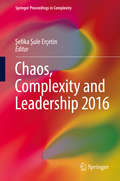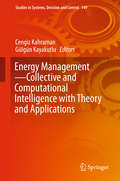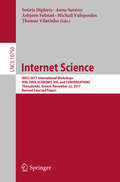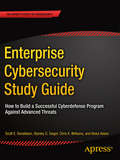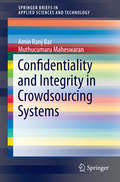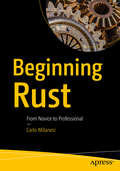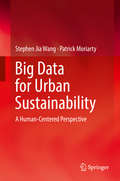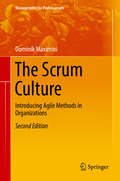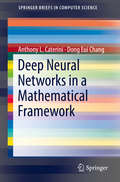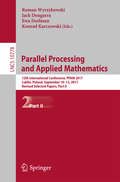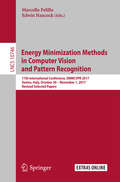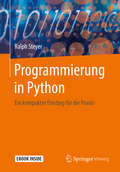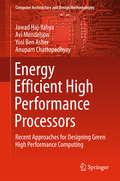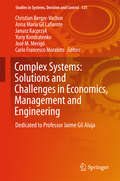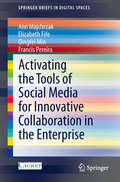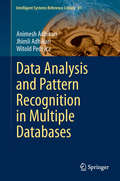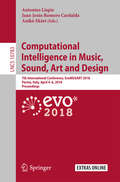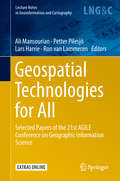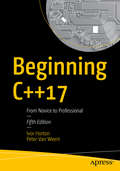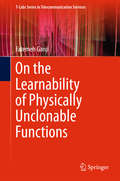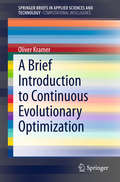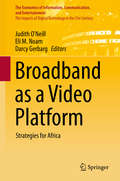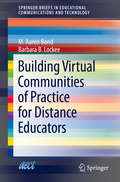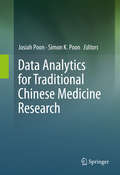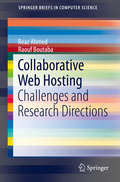- Table View
- List View
Chaos, Complexity and Leadership 2016
by Şefika Şule ErçetinThis book covers the proceedings from the 2016 International Symposium on Chaos, Complexity and Leadership, and reflects current research results of chaos and complexity studies and their applications in various fields. Included are research papers in the fields of applied nonlinear methods, modeling of data and simulations, as well as theoretical achievements of chaos and complex systems. Also discussed are leadership and management applications of chaos and complexity theory.
Energy Management—Collective and Computational Intelligence with Theory and Applications: Collective And Computational Intelligence With Theory And Applications (Studies In Systems, Decision And Control #149)
by Cengiz Kahraman Gülgün KayakutluThis book presents a selection of recently developed collective and computational intelligence techniques, which it subsequently applies to energy management problems ranging from performance analysis to economic analysis, and from strategic analysis to operational analysis, with didactic numerical examples. As a form of intelligence emerging from the collaboration and competition of individuals, collective and computational intelligence addresses new methodological, theoretical, and practical aspects of complex energy management problems. The book offers an excellent reference guide for practitioners, researchers, lecturers and postgraduate students pursuing research on intelligence in energy management. The contributing authors are recognized researchers in the energy research field.
Internet Science: Third International Conference, Insci 2016, Florence, Italy, September 12-14, 2016, Proceedings (Lecture Notes in Computer Science #9934)
by Sotiris Diplaris Anna Satsiou Asbjørn Følstad Michail Vafopoulos Thomas VilarinhoThis book constitutes the refereed post-conference proceedings of 4 workshops, held at the 4th International Conference on Internet Science, Thessaloniki, Greece, in November 2017: the Second International Workshop on the Internet for Financial Collective Awareness and Intelligence, IFIN 2017, the International Workshop on Data Economy 2017, the International Workshop on Digital Technology to Support Social Innovation, DSI 2017, and the International Workshop on Chatbot Research and Design, CONVERSATIONS 2017. The 17 full papers presented together with one short paper were carefully reviewed and selected from 27 submissions. The contributions of the IFIN workshop focus on a multidisciplinary dialogue on how to use the internet to promote financial awareness and capability among citizens whereas the papers of the Data Economy workshop show how online data change economy and business. The aim of the DSI workshop was to collect the lessons learned from different platforms and settings, and to understand the requirements and challenges for building and using digital platforms to effectively engage broad participation in the social innovation process. The papers of the Conversations workshop explore the brave new world of human-computer communication through natural language, gathering latest developments in chatbots research and design.
Enterprise Cybersecurity Study Guide: How To Build A Successful Cyberdefense Program Against Advanced Threats
by Scott E. Donaldson Stanley G. Siegel Chris K. Williams Abdul AslamUse the methodology in this study guide to design, manage, and operate a balanced enterprise cybersecurity program that is pragmatic and realistic in the face of resource constraints and other real-world limitations. This guide is an instructional companion to the book Enterprise Cybersecurity: How to Build a Successful Cyberdefense Program Against Advanced Threats. The study guide will help you understand the book’s ideas and put them to work. The guide can be used for self-study or in the classroom.Enterprise cybersecurity is about implementing a cyberdefense program that will succeed in defending against real-world attacks. While we often know what should be done, the resources to do it often are not sufficient. The reality is that the Cybersecurity Conundrum—what the defenders request, what the frameworks specify, and what the budget allows versus what the attackers exploit—gets in the way of what needs to be done. Cyberattacks in the headlines affecting millions of people show that this conundrum fails more often than we would prefer.Cybersecurity professionals want to implement more than what control frameworks specify, and more than what the budget allows. Ironically, another challenge is that even when defenders get everything that they want, clever attackers are extremely effective at finding and exploiting the gaps in those defenses, regardless of their comprehensiveness. Therefore, the cybersecurity challenge is to spend the available budget on the right protections, so that real-world attacks can be thwarted without breaking the bank.People involved in or interested in successful enterprise cybersecurity can use this study guide to gain insight into a comprehensive framework for coordinating an entire enterprise cyberdefense program.What You’ll Learn Know the methodology of targeted attacks and why they succeed Master the cybersecurity risk management process Understand why cybersecurity capabilities are the foundation of effective cyberdefenses Organize a cybersecurity program's policy, people, budget, technology, and assessment Assess and score a cybersecurity program Report cybersecurity program status against compliance and regulatory frameworks Use the operational processes and supporting information systems of a successful cybersecurity program Create a data-driven and objectively managed cybersecurity program Discover how cybersecurity is evolving and will continue to evolve over the next decade Who This Book Is For Those involved in or interested in successful enterprise cybersecurity (e.g., business professionals, IT professionals, cybersecurity professionals, and students). This guide can be used in a self-study mode. The book can be used by students to facilitate note-taking in the classroom and by Instructors to develop classroom presentations based on the contents of the original book, Enterprise Cybersecurity: How to Build a Successful Cyberdefense Program Against Advanced Threats.
Confidentiality and Integrity in Crowdsourcing Systems (SpringerBriefs in Applied Sciences and Technology)
by Amin Ranj Bar Muthucumaru MaheswaranConfidentiality and Integrity in Crowdsourcing Systems focuses on identity, privacy, and security related issues in crowdsourcing systems and in particular the confidentiality and integrity of online data created via crowdsourcing. This book begins with an introduction to crowdsourcing and then covers the privacy and security challenges of Confidentiality. The book examines integrity in these systems and the management and control of crowdsourcing systems.
Beginning Rust: From Novice To Professional
by Carlo MilanesiLearn to program with Rust in an easy, step-by-step manner on Unix, Linux shell, macOS and the Windows command line. As you read this book, you’ll build on the knowledge you gained in previous chapters and see what Rust has to offer. Beginning Rust starts with the basics of Rust, including how to name objects, control execution flow, and handle primitive types. You’ll see how to do arithmetic, allocate memory, use iterators, and handle input/output. Once you have mastered these core skills, you’ll work on handling errors and using the object-oriented features of Rust to build robust Rust applications in no time.Only a basic knowledge of programming is required, preferably in C or C++. To understand this book, it's enough to know what integers and floating-point numbers are, and to distinguish identifiers from string literals.After reading this book, you'll be ready to build Rust applications. What You'll LearnGet started programming with RustUnderstand heterogeneous data structures and data sequencesDefine functions, generic functions, structs, and moreWork with closures, changeable strings, ranges and slicesUse traits and learn about lifetimes Who This Book Is For Those who are new to Rust and who have at least some prior experience with programming in general: some C/C++ is recommended particularly.
Big Data for Urban Sustainability
by Stephen Jia Wang Patrick MoriartyThis book presents a practical framework for the application of big data, cloud, and pervasive and complex systems to sustainable solutions for urban environmental challenges. It covers the technologies, potential, and possible and impact of big data on energy efficiency and the urban environment.The book first introduces key aspects of big data, cloud services, pervasive computing, and mobile technologies from a pragmatic design perspective, including sample open source firmware. Cloud services, mobile and embedded platforms, interfaces, operating system design methods, networking, and middleware are all considered. The authors then explore in detail the framework, design principles, architecture and key components of developing energy systems to support sustainable urban environments. The included case study provides a pathway to improve the eco-efficiency of urban transport, demonstrating how to design an energy efficient next generation urban navigation system by leveraging vast cloud data sets on user-behavior. Ultimately, this resource maps big data’s pivotal intersection with rapid global urbanization along the path to a sustainable future.
The Scrum Culture: Introducing Agile Methods In Organizations (Management For Professionals)
by Dominik MaximiniThis book is a guide for managers, Scrum Masters and agile coaches who are interested in agile organizational methods and who are planning to introduce Scrum at their own company. Scrum is not only a product development framework but can also be used to structure activities for agile and lean organizational development.Divided into six major parts, the book first introduces and defines the Scrum Culture briefly. It explains its relevance, highlights a number of pain points typical for first encounters with Scrum, and embeds it in an introduction to organizational change. This is complemented with many real-life examples that help to apply the concepts to readers’ own specific contexts. The second part describes the principles of introducing Scrum in detail, while the third part embarks on the practical application of these principles, drawing on a wealth of experience gathered in many successful introduction projects. Part four focuses on a detailed case study of a Scrum transformation before part five provides the scientific background information and study details that led to the findings in part one. In closing, part six offers a number of appendices with extensive information on Scrum and its principles.The second edition of this book has been updated throughout and fundamentally re-organized for better readability.
Deep Neural Networks in a Mathematical Framework (SpringerBriefs in Computer Science)
by Anthony L. Caterini Dong Eui ChangThis SpringerBrief describes how to build a rigorous end-to-end mathematical framework for deep neural networks. The authors provide tools to represent and describe neural networks, casting previous results in the field in a more natural light. In particular, the authors derive gradient descent algorithms in a unified way for several neural network structures, including multilayer perceptrons, convolutional neural networks, deep autoencoders and recurrent neural networks. Furthermore, the authors developed framework is both more concise and mathematically intuitive than previous representations of neural networks.This SpringerBrief is one step towards unlocking the black box of Deep Learning. The authors believe that this framework will help catalyze further discoveries regarding the mathematical properties of neural networks.This SpringerBrief is accessible not only to researchers, professionals and students working and studying in the field of deep learning, but also to those outside of the neutral network community.
Parallel Processing and Applied Mathematics: 4th International Conference, Ppam 2001, Naleczow, Poland, September 9-12, 2001, Revised Papers (Lecture Notes in Computer Science #2328)
by Roman Wyrzykowski Jack Dongarra Ewa Deelman Konrad KarczewskiThe two-volume set LNCS 10777 and 10778 constitutes revised selected papers from the 12th International Conference on Parallel Processing and Applied Mathematics, PPAM 2017, held in Lublin, Poland, in September 2017.The 49 regular papers presented in the proceedings were selected from 98 submissions. For the workshops and special sessions, that were held as integral parts of the PPAM 2017 conference, a total of 51 papers was accepted from 75 submissions. The papers were organized in topical sections named as follows:Part I: numerical algorithms and parallel scientific computing; particle methods in simulations; task-based paradigm of parallel computing; GPU computing; parallel non-numerical algorithms; performance evaluation of parallel algorithms and applications; environments and frameworks for parallel/distributed/cloud computing; applications of parallel computing; soft computing with applications; and special session on parallel matrix factorizations.Part II: workshop on models, algorithms and methodologies for hybrid parallelism in new HPC systems; workshop power and energy aspects of computations (PEAC 2017); workshop on scheduling for parallel computing (SPC 2017); workshop on language-based parallel programming models (WLPP 2017); workshop on PGAS programming; minisymposium on HPC applications in physical sciences; minisymposium on high performance computing interval methods; workshop on complex collective systems.
Energy Minimization Methods in Computer Vision and Pattern Recognition: Second International Workshop, Emmcvpr'99, York, Uk, July 26-29, 1999, Proceedings (Lecture Notes in Computer Science #1654)
by Marcello Pelillo Edwin HancockThis volume constitutes the refereed proceedings of the 11th International Conference on Energy Minimization Methods in Computer Vision and Pattern Recognition, EMMCVPR 2017, held in Venice, Italy, in October/November 2017. The 37 revised full papers were carefully reviewed and selected from 51 submissions. The papers are organized in topical sections on Clustering and Quantum Methods; Motion and Tracking; Image Processing and Segmentation; Color, Shading and Reflectance of Light; Propagation and Time-evolution; and Inference, Labeling, and Relaxation.
Programmierung in Python: Ein Kompakter Einstieg Für Die Praxis
by Ralph SteyerWer heute das Programmieren lernen möchte, kommt nicht daran vorbei, sich mit einer der beliebtesten Programmiersprachen für Einsteiger und Profis zu befassen: Python. Mit Python hat ihr Erfinder, Guido van Rossum, einen Nerv der Zeit getroffen, denn das Konzept dahinter bietet viele Ansätze, Lösungen und Vorgehensweise für Probleme, die andere Sprachen so nicht integrieren. Das Potential dieser einfachen und übersichtlichen Programmiersprache haben auch viele Universitäten erkannt, die mittlerweile in den Anfängerkursen der Informatik-bezogenen Studiengänge Python statt Java als Einsteigersprache lehren. Der klare Programmierstil legt darüber hinaus eine hervorragende Grundlage für das spätere Erlernen weiterer Sprachen. Denn Python unterstützt nicht nur die objektorientierte und aspektorientierte, sondern auch die strukturierte und funktionale Programmierung. So wird der Programmierer nicht zu einem einzigen Programmierstil gezwungen, sondern kann flexibel das am besten geeignete Paradigma für die jeweilige Aufgabe wählen. Der universelle Zugang, der es möglich macht, die Erfahrungen aus anderen Programmierkonzepten mehr oder weniger direkt weiter zu nutzen, ist ein weiterer Grund für den Erfolg von Python. Dieses Buch ist ein idealer Einstieg in die Programmierung mit Python. Ausführlich erläutert der Autor die elementaren Grundlagen, die nötig sind, um mit dieser Sprache Programme zu erstellen und zu pflegen. Daneben zeigt er, wie sich die OOP mit Python realisieren lässt und wie man Module und API-Schnittstellen integriert. Diverse weiterführende Themen wie die Erstellung grafischer Oberflächen oder der Zugriff auf Dateien und Datenbanken runden das Fachbuch ab. Einfache Beispiele veranschaulichen die grundsätzliche Anwendung der verschiedenen Techniken und machen das Buch dadurch zu einer unbedingten Empfehlung für Einsteiger und Praktiker, die die Programmierung mit Python lernen wollen.
Energy Efficient High Performance Processors: Recent Approaches For Designing Green High Performance Computing (Computer Architecture and Design Methodologies)
by Jawad Haj-Yahya Avi Mendelson Yosi Ben Asher Anupam ChattopadhyayThis book explores energy efficiency techniques for high-performance computing (HPC) systems using power-management methods. Adopting a step-by-step approach, it describes power-management flows, algorithms and mechanism that are employed in modern processors such as Intel Sandy Bridge, Haswell, Skylake and other architectures (e.g. ARM). Further, it includes practical examples and recent studies demonstrating how modem processors dynamically manage wide power ranges, from a few milliwatts in the lowest idle power state, to tens of watts in turbo state. Moreover, the book explains how thermal and power deliveries are managed in the context this huge power range. The book also discusses the different metrics for energy efficiency, presents several methods and applications of the power and energy estimation, and shows how by using innovative power estimation methods and new algorithms modern processors are able to optimize metrics such as power, energy, and performance. Different power estimation tools are presented, including tools that break down the power consumption of modern processors at sub-processor core/thread granularity. The book also investigates software, firmware and hardware coordination methods of reducing power consumption, for example a compiler-assisted power management method to overcome power excursions. Lastly, it examines firmware algorithms for dynamic cache resizing and dynamic voltage and frequency scaling (DVFS) for memory sub-systems.
Complex Systems: Solutions and Challenges in Economics, Management and Engineering
by Janusz Kacprzyk Yuriy Kondratenko Christian Berger-Vachon Anna María Gil Lafuente José M. Merigó Carlo Francesco MorabitoThis book presents an authoritative collection of contributions reporting on fuzzy logic and decision theory, together with applications and case studies in economics and management science. Dedicated to Professor Jaume Gil Aluja in recognition of his pioneering work, the book reports on theories, methods and new challenges, thus offering not only a timely reference guide but also a source of new ideas and inspirations for graduate students and researchers alike.
Activating the Tools of Social Media for Innovative Collaboration in the Enterprise (SpringerBriefs in Digital Spaces)
by Ann Majchrzak Elizabeth Fife Qingfei Min Francis PereiraThe use of social media tools in the enterprise is expanding rapidly and yet, firms are still unclear about the overall value of this activity and how best to facilitate useful outcomes. The focus of this book is, from a managerial standpoint, the control of information, the extent to which such tools can enhance employee satisfaction and how best to use social media tools to attain specific outcomes including innovative collaboration. As companies turn to IT solutions as substitutes for face-to-face engagements, an understanding of the social dynamics - how employees can best communicate, find and use information and generate motivation through computer-mediated activities is fundamental. Lingering questions relate to the strategic use of these tools; many large companies are using Facebook-like applications due to employee demand, but are not studying outcomes comprehensively or managing processes to create desired outcomes. This book fills this knowledge gap through examining the process and results of a controlled study in two companies, one in the US and the other in China. In each company "wiki challenges" were introduced to employees who were provided guidelines to produce goal-oriented outcomes. The book examine the results in each case and suggest guidelines for firms to achieve "wiki-readiness" to support innovation and co-creation.
Data Analysis and Pattern Recognition in Multiple Databases (Intelligent Systems Reference Library #61)
by Witold Pedrycz Animesh Adhikari Jhimli AdhikariPattern recognition in data is a well known classical problem that falls under the ambit of data analysis. As we need to handle different data, the nature of patterns, their recognition and the types of data analyses are bound to change. Since the number of data collection channels increases in the recent time and becomes more diversified, many real-world data mining tasks can easily acquire multiple databases from various sources. In these cases, data mining becomes more challenging for several essential reasons. We may encounter sensitive data originating from different sources - those cannot be amalgamated. Even if we are allowed to place different data together, we are certainly not able to analyze them when local identities of patterns are required to be retained. Thus, pattern recognition in multiple databases gives rise to a suite of new, challenging problems different from those encountered before. Association rule mining, global pattern discovery and mining patterns of select items provide different patterns discovery techniques in multiple data sources. Some interesting item-based data analyses are also covered in this book. Interesting patterns, such as exceptional patterns, icebergs and periodic patterns have been recently reported. The book presents a thorough influence analysis between items in time-stamped databases. The recent research on mining multiple related databases is covered while some previous contributions to the area are highlighted and contrasted with the most recent developments.
Computational Intelligence in Music, Sound, Art and Design
by Antonios Liapis Juan Jesús Romero Cardalda Anikó EkártThis book constitutes the refereed proceedings of the 7th International Conference on Evolutionary Computation in Combinatorial Optimization, EvoMUSART 2018, held in Parma, Italy, in April 2018, co-located with the Evo*2017 events EuroGP, EvoCOP and EvoApplications. The 21 revised full papers presented were carefully reviewed and selected from 33 submissions. The papers cover a wide range of topics and application areas, including: generative approaches to music and visual art; medical art therapy; visualization in virtual reality; jewellery design; interactive evolutionary computation; and the art theory of evolutionary computation.
Geospatial Technologies for All: Selected Papers Of The 21st Agile Conference On Geographic Information Science (Lecture Notes in Geoinformation and Cartography)
by Ali Mansourian Petter Pilesjö Lars Harrie Ron Van LammerenThis book presents the research papers accepted for the 21st AGILE Conference on Geographic Information Science, held at Lund University Geographical Information Systems (GIS) Centre, Sweden on 12–15 June 2018. It discusses the role of geospatial technologies in the digitalization of society and is intended primarily for professionals and researchers in fields that can benefit from geoinformation – both within and outside the area of geographic information science.
Beginning C++17: From Novice To Professional
by Ivor Horton Peter Van WeertLearn how to program using the updated C++17 language. You'll start with the basics and progress through step-by-step examples to become a working C++ programmer. All you need are Beginning C++17 and any recent C++ compiler and you'll soon be writing real C++ programs. There is no assumption of prior programming knowledge.All language concepts that are explained in the book are illustrated with working program examples, and all chapters include exercises for you to test and practice your knowledge. Code downloads are provided for all examples from the text and solutions to the exercises.This latest edition has been fully updated to the latest version of the language, C++17, and to all conventions and best practices of so-called modern C++. Beginning C++17 also introduces the elements of the C++ Standard Library that provide essential support for the C++17 language. What You'll LearnDefine variables and make decisionsWork with arrays and loops, pointers and references, strings, and moreWrite your own functions, types, and operatorsDiscover the essentials of object-oriented programmingUse overloading, inheritance, virtual functions and polymorphismWrite generic function templates and class templates Get up to date with modern C++ features: auto type declarations, move semantics, lambda expressions, and moreExamine the new additions to C++17Who This Book Is ForProgrammers new to C++ and those who may be looking for a refresh primer on the C++17 programming language in general.
On the Learnability of Physically Unclonable Functions (T-Labs Series in Telecommunication Services)
by Fatemeh GanjiThis book addresses the issue of Machine Learning (ML) attacks on Integrated Circuits through Physical Unclonable Functions (PUFs). It provides the mathematical proofs of the vulnerability of various PUF families, including Arbiter, XOR Arbiter, ring-oscillator, and bistable ring PUFs, to ML attacks. To achieve this goal, it develops a generic framework for the assessment of these PUFs based on two main approaches. First, with regard to the inherent physical characteristics, it establishes fit-for-purpose mathematical representations of the PUFs mentioned above, which adequately reflect the physical behavior of these primitives. To this end, notions and formalizations that are already familiar to the ML theory world are reintroduced in order to give a better understanding of why, how, and to what extent ML attacks against PUFs can be feasible in practice. Second, the book explores polynomial time ML algorithms, which can learn the PUFs under the appropriate representation. More importantly, in contrast to previous ML approaches, the framework presented here ensures not only the accuracy of the model mimicking the behavior of the PUF, but also the delivery of such a model. Besides off-the-shelf ML algorithms, the book applies a set of algorithms hailing from the field of property testing, which can help to evaluate the security of PUFs. They serve as a “toolbox”, from which PUF designers and manufacturers can choose the indicators most relevant for their requirements. Last but not least, on the basis of learning theory concepts, the book explicitly states that the PUF families cannot be considered as an ultimate solution to the problem of insecure ICs. As such, it provides essential insights into both academic research on and the design and manufacturing of PUFs.
A Brief Introduction to Continuous Evolutionary Optimization (SpringerBriefs in Applied Sciences and Technology)
by Oliver KramerPractical optimization problems are often hard to solve, in particular when they are black boxes and no further information about the problem is available except via function evaluations. This work introduces a collection of heuristics and algorithms for black box optimization with evolutionary algorithms in continuous solution spaces. The book gives an introduction to evolution strategies and parameter control. Heuristic extensions are presented that allow optimization in constrained, multimodal and multi-objective solution spaces. An adaptive penalty function is introduced for constrained optimization. Meta-models reduce the number of fitness and constraint function calls in expensive optimization problems. The hybridization of evolution strategies with local search allows fast optimization in solution spaces with many local optima. A selection operator based on reference lines in objective space is introduced to optimize multiple conflictive objectives. Evolutionary search is employed for learning kernel parameters of the Nadaraya-Watson estimator and a swarm-based iterative approach is presented for optimizing latent points in dimensionality reduction problems. Experiments on typical benchmark problems as well as numerous figures and diagrams illustrate the behavior of the introduced concepts and methods.
Broadband as a Video Platform: Strategies for Africa (The Economics of Information, Communication, and Entertainment)
by Eli M. Noam Judith O'Neill Darcy GerbargThis volume features contributions from a conference held in Lusaka, Zambia, to explore the role and prospects of broadband in Africa as a video platform--with emphasis on the strategies and building blocks for deployment and advancement. While it may seem that such networks and their applications are not a realistic scenario for developing countries, it would be short-sighted and economically dangerous to ignore the emerging trends. The pace of introduction of next-generation networks in industrialized countries is rapid and the developing world will not be able to stand aside. The risks of falling behind are great and in any country there will be elements of business and society who wish to forge ahead. Policymakers and network architects need to be prepared. Media companies and broadcasters, in particular, must be alert to the new developments as should be medical and educational institutions. The availability of advanced high-speed business application tools in a country will affect its participation in international transactions and its economic growth. This volume features contributions from industry leaders, policymakers and scholars, representing a variety of perspectives, including technology and infrastructure management, economic development, marketing, education and health. The authors collectively discuss how broadband deployment as a platform with sufficient speed for video may be encouraged by public policy and regulation and how investment in broadband for this and related purposes can improve the quality of life and experience in Sub Saharan Africa in media and data, while being a financeable, commercially sound business.
Building Virtual Communities of Practice for Distance Educators (SpringerBriefs in Educational Communications and Technology #1)
by M. Aaron Bond Barbara B. LockeeAs colleges, universities and other learning institutions explore teaching and learning through online environments, online communities of practice may provide solutions to organizational and professional development needs. The purpose of this book is to develop a set of guidelines for creating a virtual community of practice for faculty teaching at a distance that can easily be implemented by faculty development professionals. Designing a virtual community of practice can be operationalized using the ADDIE model to guide the process. Based on an instructional systems design process, the ADDIE model emphasizes the five core elements of the instructional systems design process: analyze, design, develop, implement and evaluate; often it serves as a project management tool or to provide a visual aid for organization of relevant tasks.
Data Analytics for Traditional Chinese Medicine Research
by Josiah Poon Simon K. PoonThis contributed volume explores how data mining, machine learning, and similar statistical techniques can analyze the types of problems arising from Traditional Chinese Medicine (TCM) research. The book focuses on the study of clinical data and the analysis of herbal data. Challenges addressed include diagnosis, prescription analysis, ingredient discoveries, network based mechanism deciphering, pattern-activity relationships, and medical informatics. Each author demonstrates how they made use of machine learning, data mining, statistics and other analytic techniques to resolve their research challenges, how successful if these techniques were applied, any insight noted and how these insights define the most appropriate future work to be carried out. Readers are given an opportunity to understand the complexity of diagnosis and treatment decision, the difficulty of modeling of efficacy in terms of herbs, the identification of constituent compounds in an herb, the relationship between these compounds and biological outcome so that evidence-based predictions can be made. Drawing on a wide range of experienced contributors, Data Analytics for Traditional Chinese Medicine Research is a valuable reference for professionals and researchers working in health informatics and data mining. The techniques are also useful for biostatisticians and health practitioners interested in traditional medicine and data analytics.
Collaborative Web Hosting: Challenges and Research Directions (SpringerBriefs in Computer Science)
by Raouf Boutaba Reaz AhmedThis brief presents a peer-to-peer (P2P) web-hosting infrastructure (named pWeb) that can transform networked, home-entertainment devices into lightweight collaborating Web servers for persistently storing and serving multimedia and web content. The issues addressed include ensuring content availability, Plexus routing and indexing, naming schemes, web ID, collaborative web search, network architecture and content indexing. In pWeb, user-generated voluminous multimedia content is proactively uploaded to a nearby network location (preferably within the same LAN or at least, within the same ISP) and a structured P2P mechanism ensures Internet accessibility by tracking the original content and its replicas. This new paradigm of information management strives to provide low or no-cost cloud storage and entices the end users to upload voluminous multimedia content to the cloud data centers. However, it leads to difficulties in privacy, network architecture and content availability. Concise and practical, this brief examines the benefits and pitfalls of the pWeb web-hosting infrastructure. It is designed for professionals and practitioners working on P2P and web management and is also a useful resource for advanced-level students studying networks or multimedia.
